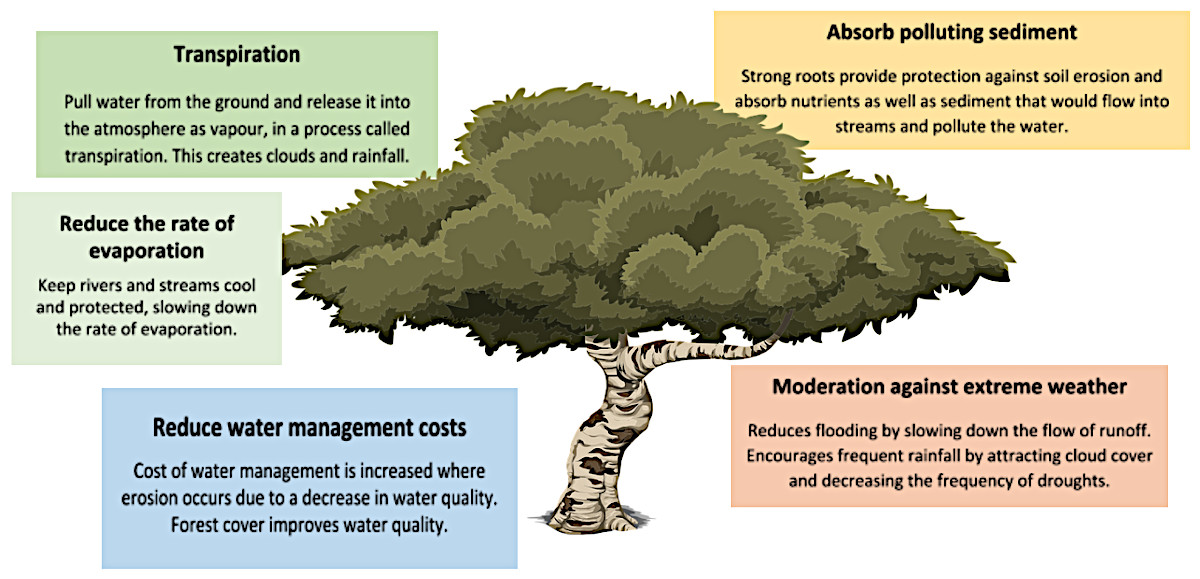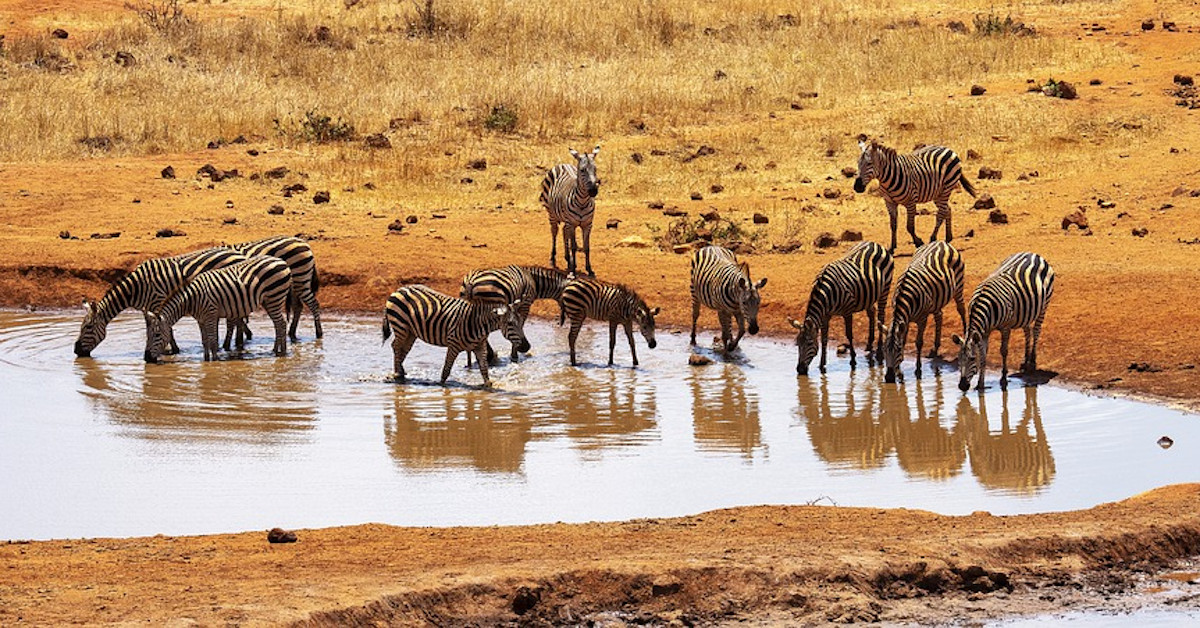The importance of the water cycle
The availability of water for all living organisms and for the regulation of local and global weather patterns is dependent on the water cycle. While just 3% of the water on earth is fresh water, two thirds of this is locked up in ice sheets, glaciers or the ground. The remainder is present in rivers, lakes and wetlands or takes the form of water vapour, as clouds or precipitation which recycle and restore fresh water sources. [1] Alterations to the water cycle can have negative effects for organisms that have adapted to a specific climate. For example, sustained drought can eliminate plant populations, while some salamander species can only survive in environments with a certain amount of soil saturation. [2]
Status in Kenya
Natural water resources in Kenya do not provide enough water in some areas and water basins are only able to reach so far; this leaves much of the population without fresh water. [15] Although clean water kiosks are situated in some parts of Kenya, most people cannot afford to purchase water, leaving many with no other choice but to walk miles to the closest water source. [3] Due to the overuse of land and rapid growth of community settlements in Kenya, and the fact that they are also used by wild animals, these sources are often polluted with water borne diseases, responsible for the death of over 5,000 children a year. [18]
Additionally, Kenya experiences persistent droughts that are becoming more frequent as a result of environmental degradation and climate change. Currently dry periods occur at least once a year, and the frequency of droughts has increased alarmingly. Longer time periods between droughts allowed farmland to recover and crops to be harvested before the next drought occurred; however this is no longer the case. During the end of 2009 and early 2010, ten million people were at risk of starvation after harvests failed as a result of drought. [6]
Deforestation maximises the ongoing water crisis in Kenya. For example, Lake Naivasha is a freshwater lake situated north west of the capital Nairobi. It once exhibited cycles of rising and falling water levels that now appear to have been disrupted. The lake is supplied by the Aberdare Mountain Range, formerly characterised by thick forests that regulated the temperature of the atmosphere, trapped moisture, promoted rainfall and supplied many other vital ecosystem services. However, there has been mass deforestation in the area and throughout Kenya over the last few decades, to make way for farmland and to supply the charcoal and timber production industries, amongst others. Decreased forest cover has led to a weakened ability of the ecosystem to trap moisture and promote cloud cover, resulting in less rainfall. Consequently, the streams and rivers that supply Lake Naivasha in addition to other lakes have shrunk or completely dried up, due to a drop in water levels. [7]

Trees provide water cycle management
75% of the world’s fresh water supply is generated by forests that guide water into rivers, lakes and the groundwater table, while promoting the formation of clouds. Trees extract groundwater via their roots and recycle it back into the atmosphere from the soil through a process called transpiration; this increases the capacity of the soil to store water. [4] The water vapour contains biological particles such as microorganisms, fungal spores and pollen, as well as other biological debris that provide a surface for atmospheric water to condense into rain droplets and cluster together to form clouds. The newly created clouds attract higher clouds that would have previously passed over the area, adding additional rain to the forest. This explains why deforestation results in increased frequencies of drought and flooding due to irregular rainfall. [12]
This lack of water can cause the landscape to shift into a barren desert environment with inhospitable living conditions. [8] Rivers and streams are kept cool by the shade trees offer. [9] This prevents the water from evaporating too rapidly, maximising the quantity of water and value of the river to both people and wildlife.
Trees are described as ‘natural sponges’ due to an ability to collect and filter rainwater, which is then released slowly into rivers and streams. Without them, the rain runs off into streams and rivers so fast that the top layer of the soil can become eroded due to the lack of roots anchoring it down. [10] This leaves the landscape vulnerable to flooding and landslides, as well as decreasing the fertility of the soil, reducing water infiltration and increasing the rate of runoff. [16]
The strong roots of trees not only protect against soil erosion but also absorb nutrients and sediment that would otherwise flow into streams and rivers, polluting the water. Communities in Kenya have to depend on expensive water filtration systems to provide clean water and this cost is maximised where erosion occurs, due to poorer water quality. [13] Therefore, healthy functioning forest ecosystems are able to act as natural infrastructure and reduce water management costs.

Water cycle management benefits for the local community
Today, citizens of developed countries often take having access to clean drinking water for granted. In contrast, most of Kenya’s citizens walk miles every day to obtain water that is often unsuitable for human consumption. Wildlife also depends on these same water sources. Reforesting Kenya’s landscape creates a wealth of benefits for the local community and is the most practical and affordable method of sustaining a higher quantity and quality supply of fresh water for both people and wildlife. [14]
However, it is important to consider that just planting trees does not always increase the water supply. This depends largely on selecting suitable sites and species of trees, as well as scale, forest structure, density and management methods put in place. [13]
Forest cover has been directly linked to reducing the costs of drinking water treatment. This is due to the ability of trees to remove excess agricultural fertiliser before the chemicals run off into rivers and streams, polluting the water. [16] Furthermore, more regular and predictable rainfall would increase agricultural yields, decrease irrigation cycles and improve food security in these areas. [11]
Impact on overall ecosystem health and other ecosystem services
Local deforestation in Kenya can affect the global water cycle. Greenpeace have stated that deforestation in Kenya causes decreased rainfall in the Midwest of the USA by 5-35%, negatively affecting agricultural production and other sectors. [5]
Changes in the water cycle as a result of deforestation directly affect the carbon cycle. Carbon sequestration is a co-benefit of the recycling of precipitation that simultaneously cools planetary surfaces. We know that removing trees allows more carbon to remain in the atmosphere. [17] The increasing incidence of drought can worsen fires in shrublands and grasslands, heighten the potential for forest fires, resulting in further loss of forest cover, and release even more carbon dioxide into the atmosphere. [9]

In summary, the importance of trees in the global regulation of water is often overlooked, but forests can make a major difference to the quality and quality of water available to us if planted and nurtured appropriately.
To find out more about the work of The Word Forest Organisation, have a look around our website and watch our film #TreesAreTheKey narrated by Kate Winslet.
References
1: https://gpm.nasa.gov/resources/faq/why-are-water-cycle-processes-important
2: https://socratic.org/questions/why-is-the-water-cycle-important-to-all-life-on-the-earth
3: https://www.bbc.co.uk/news/world-africa-50253189
4: https://eos.org/research-spotlights/how-forest-structure-influences-the-water-cycle
5: https://www.wri.org/blog/2017/03/3-surprising-ways-water-depends-healthy-forests
6: https://issafrica.org/iss-today/the-cycle-of-drought-in-kenya-a-looming-humanitarian-crisis
7: https://www.voanews.com/archive/kenya-experiencing-effects-deforestation-climate-change-0
8: http://sustainablefootprint.org/nederlands-trees-and-the-water-cycle/
9: http://coolgeography.co.uk/advanced/Human_Influences_Water_Cycle.php
10: https://blog.ecosia.org/trees-kenya-water-towers-photography-green-belt-movement-ecosia/
11: https://www.kiwash.org/planting_trees_to_protect_water_and_increase_climate_resilience
12: https://forestsnews.cifor.org/49010/linking-trees-and-water?fnl=
13: https://sdg.iisd.org/commentary/guest-articles/afforestation-increases-water-supply-but-only-with-these-consideLinking trees and waterrations/
14: https://www.thegiftedtree.com/how-to-improve-water-quality-by-planting-trees/
15: https://thewaterproject.org/water-crisis/water-in-crisis-kenya
16: https://onetreeplanted.org/blogs/stories/trees-clean-water
17: https://www.sciencedaily.com/releases/2017/03/170320110039.htm
18: https://www.unicef.org/media/media_19974.html
Alice O’Grady and the Team





